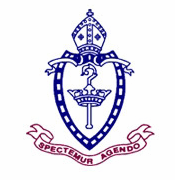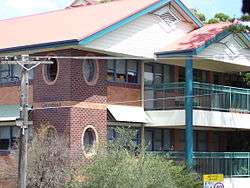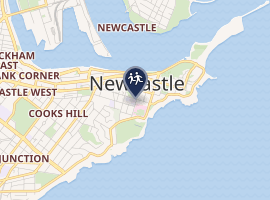Newcastle Grammar School
The Newcastle Grammar School is a dual-campus independent Anglican co-educational non-selective primary and secondary day school, located in Newcastle, in the Hunter Region of New South Wales, Australia.
| Newcastle Grammar School | |
|---|---|
 | |
 | |
| Location | |
 Newcastle Grammar School Location in New South Wales | |
Australia | |
| Coordinates | 32°55′47″S 151°46′50″E |
| Information | |
| Former names |
|
| Type | Independent co-educational non-selective primary and secondary day school |
| Motto | Latin: Spectemur Agendo (Let us be judged by our actions) |
| Religious affiliation(s) | Anglican Diocese of Newcastle |
| Denomination | Anglicanism |
| Established |
|
| Status | Open |
| Educational authority | New South Wales Department of Education |
| Chairman | Keith Lynch |
| Head of school | Erica Thomas |
| Teaching staff | >90 |
| Years offered | Early learning; K–12 |
| Enrolment | c. 740 |
| Campus |
|
| Campus type | Suburban |
| Houses | |
| Colour(s) | Blue and burgundy |
| Slogan | Towards a Brighter Future |
| Affiliations |
|
| Website | www |

| |
Established in 1859 as the Newcastle Boys' Grammar School, but was officially established in 1918 as the Girls' Grammar School of England, a girls only private school. The school was relocated to Morpeth during World War II but then relocated back to Newcastle. The school finally became co-educational and stopped boarding in 1978. From 1976 to 1991, the school was run by the Anglican Diocese of Newcastle but was handed back to be administered by the Newcastle Grammar School Company Limited.[1]
Newcastle Grammar is affiliated with the Anglican Diocese of Newcastle,[2] the Association of Heads of Independent Schools of Australia (AHISA),[3] the Junior School Heads Association of Australia (JSHAA),[4] the Association of Independent Schools of New South Wales (AISNSW)[5] and Hunter Region Independent Schools (HRIS).
Heads of School
The following individuals served as Head of School (or any precedent title) of the Newcastle Grammar School:
| Ordinal | Officeholder | Term start | Term end | Time in office | Notes |
|---|---|---|---|---|---|
| 1 | E K Yeatman | 1859 | 1862 | 2–3 years | |
| 2 | H S Millard | 1865 | 1896 | 30–31 years | |
| 3 | M E Lawrance | 1918 | 1932 | 13–14 years | |
| 4 | Z E Martin | 1933 | 1951 | 17–18 years | |
| 5 | M Roberts | 1952 | 1959 | 6–7 years | |
| 6 | E Heath | 1960 | 1964 | 3–4 years | |
| 7 | L Thompson | 1965 | 1967 | 1–2 years | |
| 8 | K Stewart | 1968 | 1976 | 7–8 years | |
| 9 | D Lloyd | 1977 | 1977 | years | |
| 10 | R H Morgan (Executive Principal) | 1977 | 1991 | 13–14 years | |
| 11 | A Coombes | 1978 | 1985 | 6–7 years | |
| 12 | B L Charlton | 1986 | 1988 | 1–2 years | |
| 13 | A Green | 1989 | 2014 | 24–25 years | |
| 14 | Erica Thomas | 2014 | incumbent | 5–6 years |
Campuses
Newcastle Grammar School is situated on two campuses.
Park Campus
Located in Cooks Hill, approximately 2 km (1.2 mi) from the Hill Campus, this campus features a pre-school that caters for children in the years prior to starting kindergarten, as well as a library, music room and computer rooms. The Sandi Warren Performance Centre is used for musical and productions, assemblies, physical education lessons, lectures and dinners. Park Campus is across from a national park which has sports facilities such as netball/basketball courts and large soccer fields. In addition, it caters for students Year K to Year 4.
Hill Campus
Located on The Hill overlooking the city of Newcastle and the beaches, this campus caters for students from Year 5 to Year 12 in a mix of historic and modern buildings. The areas of Hill Campus have names associated with various figures that contributed to the founding and leadership of Newcastle Grammar School and Newcastle. On the east side of the school are the two areas of the courts, which are used for physical education, and Stewart building, used as the office for sports teachers and the area for Years 5 and 6. The west side of the school is the Merrick Courtyard which acts as a sitting area for students and location of the Hill Campus canteen, art rooms, student lockers and office area for the Heads of House for middle and senior school and the House Coordinators. The Parnell building has lockers, science labs, music basement, maths and geography classrooms, the maths department office and the Tyrrell Library, which is also the site of the offices for languages and English staff. The Hill Building is a four story building designed for classrooms such as the languages of French, Japanese and Mandarin, kitchen areas for teaching hospitality computer labs on various storeys, English classrooms and office areas for social studies and humanities. The roof of Hill is only accessible at various times, and the uppermost floor is only reserved for Year 12s. The Hill basement is used for technology and woodwork, and the first floor is used for classrooms, computer lab and a kitchen area for hospitality and food tech. Dividing the school into east and west is the Horbury Hunt Hall, used for assemblies and functions.
In 2002 it was reported that school management at The Hill campus put into place measures to reduce student anxiety.[6]
Curriculum, co-curricular and extra-curricular activities
Students are expected to participate in a minimum of one co-curricular activity from Years 5 to 12.[7] These include sporting activities, such as tennis or touch football; and musical activities, such as concert band or symphony orchestra. Students can perform in any sporting event, but for symphony orchestra, the student must audition to show that they are a suitable level to perform.
House system
Upon entry to the School, each student is allocated, according to age and gender, or family tradition, to one of the four houses:
- Hunter (green) – named after John Hunter
- Macquarie (red) – named after Lachlan Macquarie
- Shortland (mustard yellow) – named after John Shortland
- Tyrrell (sky blue) – named after Bishop Tyrrell
On the Hill Campus, each house is divided into two sections – Stewart (years 5 to 8) and Berkeley (years 9 to 12) – with each section composed of small, vertically streamed, single sex mentor groups. The mentor, supported by the House Coordinator, monitors students' overall progress and well-being, and establishes a long term, caring relationship with them. Mentor groups meet during a designated period every fortnight and also sit together during chapel and Head of School's assemblies. Each house has two captains for each section, who are voted in by the students of each section. The students vote for one male and one female captain to be the house captains for Stewart and Berkeley.
At Park Campus (pre-school to year 4), the roles of the House Coordinator and mentor are undertaken by the Class Teacher and the Assistant Head of Park Campus.
Every term is a specific house's term, wherein which the house has to organise House Day, a day of celebrating an aspect of mindfulness that the house has chosen.
Houses participate in three annual events: the swimming carnival, the athletics carnival and cross-country. The main purpose of this event is to select students to represent the school at HRIS.
References
- "Newcastle Grammar School". School Choice. Archived from the original on 14 September 2009. Retrieved 12 March 2008.
- "Directory of Anglican Schools & Independent Schools with Anglican Affiliation" (PDF). News South Wales. NSW Provincial Commission on Christian Education. March 2007. p. 16. Retrieved 12 March 2008.
- "New South Wales". School Directory. Association of Heads of Independent Schools of Australia. 2008. Archived from the original on 19 October 2008. Retrieved 12 March 2008.
- "JSHAA New South Wales Directory of Members". New South Wales Branch. Junior School Heads' Association of Australia. 2007. Archived from the original on 17 January 2008. Retrieved 12 March 2008.
- "Hunter Region". NSW Independent Schools by Region. Association of Independent Schools of New South Wales. Archived from the original on 18 May 2008. Retrieved 12 March 2008.
- "The way ahead: sit where you like and keep the same teacher". The Sydney Morning Herald. 10 June 2002.
- Newcastle Grammar School Co-curricular Activities 2004